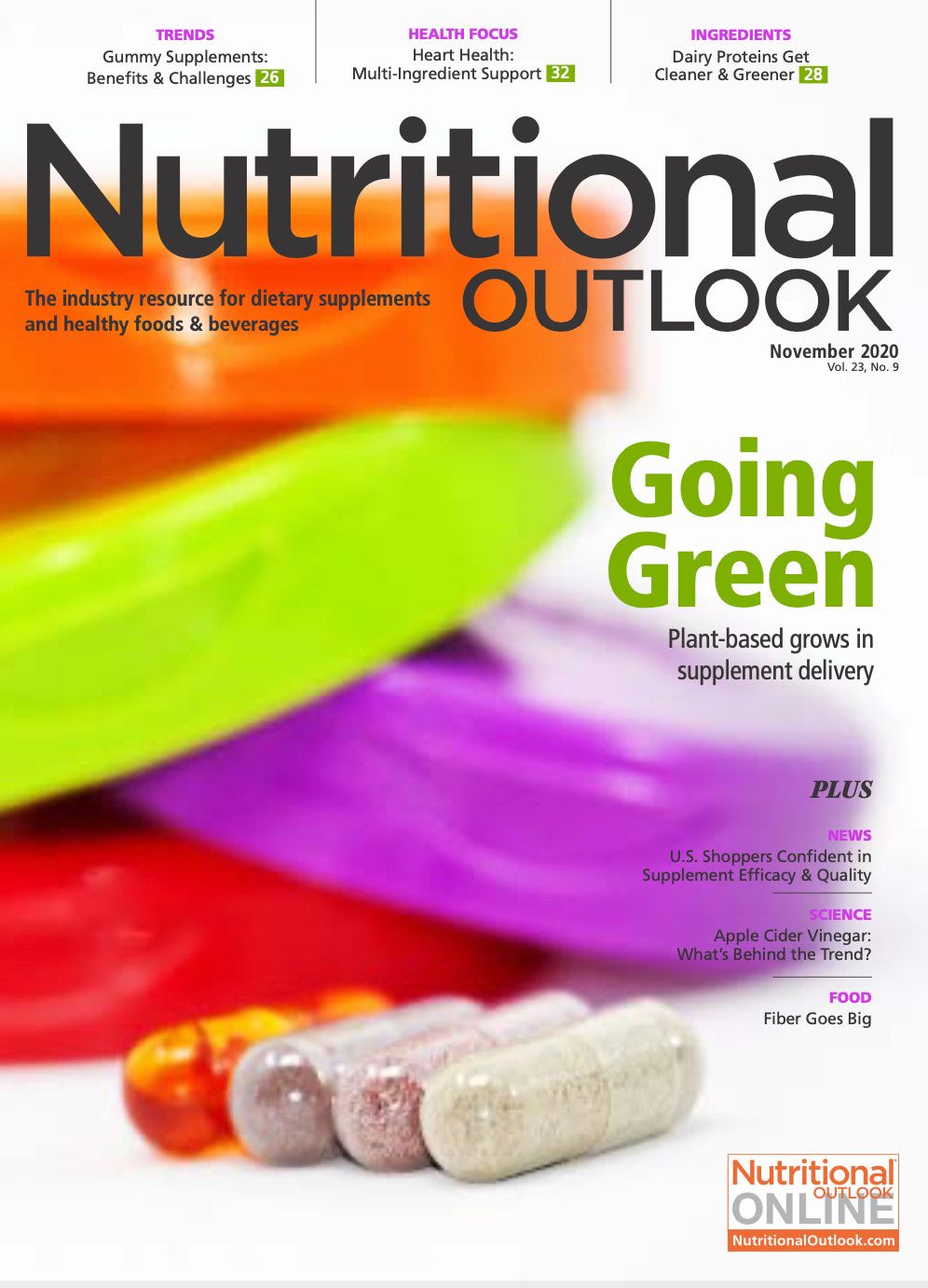Plant-based delivery systems continue their rise in dietary supplements
Plant-based dosing options are in demand as today’s health-and-wellness climate steers consumers toward cleaner, greener options.
Photo credit © Boyet&Novoa - Stock.adobe.com

By now, the presence on shelves and in shopping carts of plant-based dairy, plant-based meat, plant-based proteins—even plant-based home, hair, and skincare products—should seem about as mainstream as the mainstream products these alternatives attempt to replicate.
But plant-based supplement delivery systems—are those a thing?
You bet they are, and they have been for some time. In fact, plant-based dosing options are becoming even more of an item as today’s health-and-wellness climate steers consumers toward cleaner, greener options.
As Michael Baumann, global strategic marketing manager, dietary supplements, DuPont Nutrition & Biosciences (New Century, KS), says, “Plant-based delivery formats aren’t new to the dietary supplement industry, but they’ve gained tremendous market traction as shoppers increasingly focus on the ingredients in their products and where they’re sourced from.”
That, in turn, has product developers focusing on the plant-based solutions that help them deliver supplements as effectively as ever, but in a form that’s more acceptable to all.
What’s Old Is New Again
The practice of looking to plant-based delivery materials is a time-honored tradition in the nutrition and pharmaceutical industries.
As far back as the mid-1800s, explains Benjamin Roscoe, application development and innovation manager for pharma solutions at DuPont Nutrition & Biosciences, “carrageen moss”—or Irish moss—appeared as a “new gelatin” in one-piece capsules (not to mention as a thickening agent in traditional Irish puddings).
Similarly, modern-day carrageenan—produced industrially but still extracted from red seaweed—has a long history of use in nutritional products and continues to help thicken supplement matrices, control active-ingredient release, and stabilize delivery formats ranging from gummies to softgels, among other functions.
But the latest generation of plant-based options is a far cry from the Irish mosses of yore.
“Today’s solutions have superior thermal stability, provide a different but still positive consumer experience, permit broad formulation options and processing windows, and aren’t prone to crosslinking,” Baumann points out. “These technologies may have started as higher-priced, niche offerings, but thanks to ongoing innovations, they’ve emerged as more broadly used and economically attractive alternatives to gelatin.”
The Gold Standard…
Animal-sourced gelatin—ubiquitous in multiple dosing forms—does tend to be the ingredient that plant-based delivery solutions aim to replace.
And why is gelatin so prevalent? Because, claims Liz Clarke, CFS, technical marketing manager, Nitta Gelatin (Morrisville, NC), “Gelatin is still the gold standard for gummies and capsules in North America, and for good reason.”
To start with, physical properties like thermoreversibility and pH-independent gelling make it “incredibly easy to work and rework with,” Clarke says, noting that these properties don’t frequently show up in contemporary plant-based options.
Plant-based gummy gelling agents—used individually or in combination—also can’t match gelatin’s texture or workability, she adds. “And having previously made thousands of batches of gummies as Nitta’s application scientist, I can personally attest to this.”
Whereas plant-based alternatives are often what Clarke calls “highly processed” synthetic additives, a “natural,” kitchen-cupboard ingredient like gelatin may actually prove more attractive in applications—at least when being plant-based isn’t a mandate.
And finally, although plant-based “collagen boosters” made with ingredients like vitamin C and hyaluronic acid are available, the bioactive collagen dipeptides unique to gelatin—proline-hydroxyproline and hydroxyproline glycine, for example—are clinically proven to support healthy skin and joints, Clarke says.
…or Not?
But gelatin has its drawbacks.
For one, it’s heat-challenged. As Roscoe explains, “Some dietary supplements, like pasty multivitamins and vitamin E, require extra heating to improve processability during soft-capsule manufacturing. Gelatin, with its relatively low melt point, can be challenging here and create quality issues. Seaweed extracts, on the other hand, represent an interesting alternative to gelatin, withstanding higher temperatures during manufacturing and producing superior-quality soft capsules.”
Gelatin can also interact inside the capsule shell with fill materials like vitamin C, or carrier oils like polyethylene glycol, putting the finished product at risk for brittleness, discoloration, and an inability to dissolve fully.
Room for Everyone
So having a diverse bench of workable delivery materials pays dividends for both a supplement’s functional performance and its consumer perception.
And here even Clarke agrees. As she says, “There’s room in the market for functional ingredients that suit a variety of dietary and lifestyle choices,” adding that many of her customers offer both traditional gelatin products and those made with plant-based gelling or film-forming agents. “Depending on how you look at it—and whom you ask—there may be benefits to both product types.”
As far as Vaughn DuBow, marketing manager, Americas, Lonza Capsules & Health Ingredients (Greenwood, SC), is concerned, the trick lies in matching the delivery-system material to the finished product’s broad suite of requirements—consumer and functional.
“It’s important to consider both the target audience’s dietary preferences as well as the technical implications of the ingredients used,” he says. “Are they powders or liquids? What’s their moisture and oxygen sensitivity? What about taste and odor, as well as the release profile needed for optimal results?”
The upshot: “A delivery system not only plays an integral role in ensuring the successful delivery of ingredients and optimizing product efficacy,” he concludes; “it should also work symbiotically with the supplement ingredients for the desired results and product positioning.”
Time Capsule
One plant-based material his company turns to is pullulan, a polysaccharide product of tapioca fermentation. Lonza uses it in its Plantcaps vegetarian capsules, where its oxygen-barrier capacity provides up to three times the oxygen protection of cornstarch softgels, per unpublished Lonza data. With a dissolution profile resembling gelatin’s, it reaches full dissolution in about 30 minutes at pH 1.2. DuBow calls it “the ideal solution” for formulating with sensitive botanicals.
The company uses plant-sourced HPMC (hydroxypropyl methylcellulose) in its Vcaps and Vcaps Plus vegetarian capsules, whose low moisture content suits applications containing moisture-sensitive ingredients and hygroscopic fills, DuBow says.
HPMC also appears in the company’s DRcaps, which DuBow says are popular with plant-based probiotic brands hoping to achieve strain stability and survival. “Because they’re made from acid-resistant polymers,” he explains, “the capsules protect probiotics in the low-pH stomach environment and provide modified release and targeted delivery for complete dissolution in the intestine.”
Roscoe notes that DuPont’s Methocel family of cellulose-derived water-soluble polymers make handy gelatin alternatives in hard capsules, adding that probiotic and botanical brands “tend to prefer cellulose-based hard capsules, given their superior quality, and to address consumer preferences.”
And for its part, Catalent Consumer Health (Somerset, NJ) makes its Vegicaps soft capsules using sustainably sourced seaweed, creating a delivery system that Dan Peizer, vice president of global strategy and marketing, says tolerates fill formulations with a wider pH range than gelatin does and withstands higher temperatures during encapsulation.
“This presents formulation benefits beyond compatibility with plant-based ingredients,” he notes. “That’s important because product developers want technologies that deliver key consumer benefits without compromising experience or quality.”
Greener Gummies
In light of all these advances, DuBow ranks today’s plant-based capsules as “comparable to their animal-origin counterparts in terms of dissolution, swallowability, shelf life, ease of use, and machinability.” So impressive is their evolution that he considers them “true challengers for traditional gelatin capsules.”
But plant-based capsules are one matter; what about plant-based alternatives to traditional gelatin gummies?
“Gummies are one of the more popular delivery formats,” notes Drew Mound, application development and innovation scientist for pharma solutions at DuPont Nutrition & Biosciences. And as a promising plant base, he suggests brands use pectin, extracted from citrus peels.
“In addition to being plant-sourced, pectin is less sticky at elevated temperatures, has a clean bite, and is less tooth-packing,” Mound notes. It produces gummies with more heat stability in storage—making them less likely to “stick together or form a big lump”—and that don’t require extra cooling during shipment. “With the growing popularity of e-commerce platforms, which have requirements around thermal stability to ensure shelf life and product quality,” he says, “this is becoming more important.”
Don’t Forget Excipients
And not to be neglected in the plant-based formulation game are excipients—those flow agents, binders, and carriers that help make dietary supplements work as a whole.
According to Susan O. Freers, technical manager, Grain Processing Corp. (Muscatine, IA), sourcing such ingredients from plants has been an industry practice for years, especially in oral solid-dose forms like tablets and capsules. “More recently,” she notes, “we’ve seen significant developments in other dosage forms, such as softgel capsules, oral thin films, gummies, and chews.”
She’s also noticed a trend toward using starch and carrageenan to replace gelatin in vegetarian softgel capsules; but because “basic” starch isn’t up to the task, excipient makers have developed novel film-forming starches with properties suited to applications like softgels and oral thin films, she says.
Green and Clean
“Another area of significant growth lately is non-GMO ingredients,” Freers continues, noting that demand for identity-preserved (IP), non-GMO excipients has increased roughly tenfold in the last few years.
While her company launched its first products for the IP market 15-plus years ago, it’s since rolled out a full line of IP, non-GMO maltodextrins, syrup solids, and starches that act as binders, carriers, bulking agents, and film-formers in powders, tablets, two-piece and softgel capsules, oral thin films, gummies, and other delivery systems, she says.
And when you get down to it, issues of ingredient identity like these may be at least as important as plant-based. As DuBow says, “It’s important to understand what consumers are looking for when purchasing nutritional supplements and the terms they understand and identify with.”
Given that recent Lonza-commissioned Natural Marketing Institute (NMI) research found 80% of U.S. consumers claiming to be curious about the source of the ingredients in their products1 and 54% preferring supplements made from natural sources—an increase of nearly 60% from 20132—it’s clear that plant-based isn’t all they’re looking for.
References
- Natural Marketing Institute. Supplements/OTC/Rx Database (SORD) U.S. study (2017)
- Natural Marketing Institute. Supplements/OTC/Rx Database (SORD) U.S. study (2018)

Prinova acquires Aplinova to further increase its footprint in Latin America
April 7th 2025Prinova has recently announced the acquisition of Brazilian ingredients distributor Aplinova, which is a provider of specialty ingredients for a range of market segments that include food, beverage, supplements, and personal care.




















